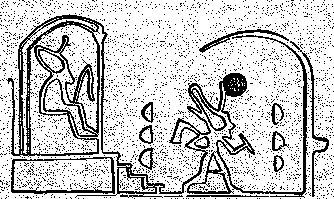It is hard to avoid connecting Wolf and Altar with the sanctuary of the 'Opener of the Way': ... The king, wearing now a short, stiff archaic mantle, walks in a grave and stately manner to the sanctuary of the wolf-god Upwaut, the 'Opener of the Way', where he anoints the sacred standard and, preceded by this, marches to the palace chapel, into which he disappears. A period of time elapses during which the pharaoh is no longer manifest ... Possibly Rei in Ga7-22 defines a day similar to winter solstice (Gregorian day 355):
From maitaki in Ga7-24 emerges what looks like a fruit, and Pharaoh likewise emerges fresh and new from the 'palace chapel': ... When he reappears he is clothed as in the Narmer palette, wearing the kilt with Hathor belt and bull's tail attatched. In his right hand he holds the flail scepter and in his left, instead of the usual crook of the Good Shepherd, an object resembling a small scroll, called the Will, the House Document, or Secret of the Two Partners, which he exhibits in triumph, proclaiming to all in attendance that it was given him by his dead father Osiris, in the presence of the earth-god Geb. 'I have run', he cries, 'holding the Secret of the Two Partners, the Will that my father has given me before Geb. I have passed through the land and touched the four sides of it. I traverse it as I desire.' ... Could it be at η Arae, 3 weeks before the solstice day, that the running should take place? ... Eta (uppercase Η, lowercase η; Greek: Ήτα Ēta) is the seventh letter of the Greek alphabet. Originally denoting a consonant /h/, its sound value in the classical Attic dialect of Ancient Greek was a long vowel ... In the system of Greek numerals it has a value of 8. It was derived from the Phoenician letter heth:
Letters that arose from Eta include the Latin H and the Cyrillic letter И ... The letter shape [of heth] ultimately goes back to a hieroglyph for 'courtyard',
(possibly named hasir in the Middle Bronze Age alphabets, while the name goes rather back to hayt, the name reconstructed for a letter derived from a hieroglyph for 'thread':
It is tempting to draw the conclusion that the maitaki type of glyph indicates a dark 'enclosure' (like the temple of the wolf-god) marking the border line between 'years'. First there is the similarity in the curious halfcircles:
Then we can note how the 'thread' hieroglyph has 3 vertically oriented 'eyes' (mata).
Coming out could be denoted with epsilon (ε, presumably like viri in design and meaning) and when Pharaoh earlier 'anoints his sacred standard' as a preparation before entering the 'palace chapel' the letter 'zayin' probably would be the proper symbol. ... Zeta (uppercase Ζ, lowercase ζ; Greek: ζήτα ... is the sixth letter of the Greek alphabet. In the system of Greek numerals, it has a value of 7. It was derived from the Phoenician letter Zayin [see letter number 7 on the bowl above]. Letters that arose from zeta include the Roman Z and Cyrillic З ... Zayin (also spelled Zain or Zayn or simply Zay) is the seventh letter of many Semitic abjads ... It represents the sound [z]. The Phoenician letter appears to be named after a sword or other weapon. (In Biblical Hebrew, 'Zayin' means sword, and the verb 'Lezayen' means to arm. In modern Hebrew, 'zayin' means penis and 'lezayen' is a vulgar term which generally means to perform sexual intercourse and is used in a similar fashion to the English word fuck, although the older meaning survives in 'maavak mezuyan' (armed struggle) and 'beton mezuyan' (armed, i.e., reinforced concrete). The Proto-Sinaitic glyph according to Brian Colless may have been called ziqq, based on a hieroglyph depicting a 'manacle' ... In K there is a running figure too, viz. at θ Lupi:
And, more conclusive, in *Kb5-15 there is a dangling 'fruit' in front of a central element much like maitaki in general construction. The Wolf star is here (as it should be) η. The 'Temple' star in Ara does not arrive until a week beyond the end of the K text. It cannot be used, and then the next best could be η Lupi, in right ascension day 242. Perhaps we should understand this place as equivalent to the sanctuary of Upwaut, the Opener of the Way. |







